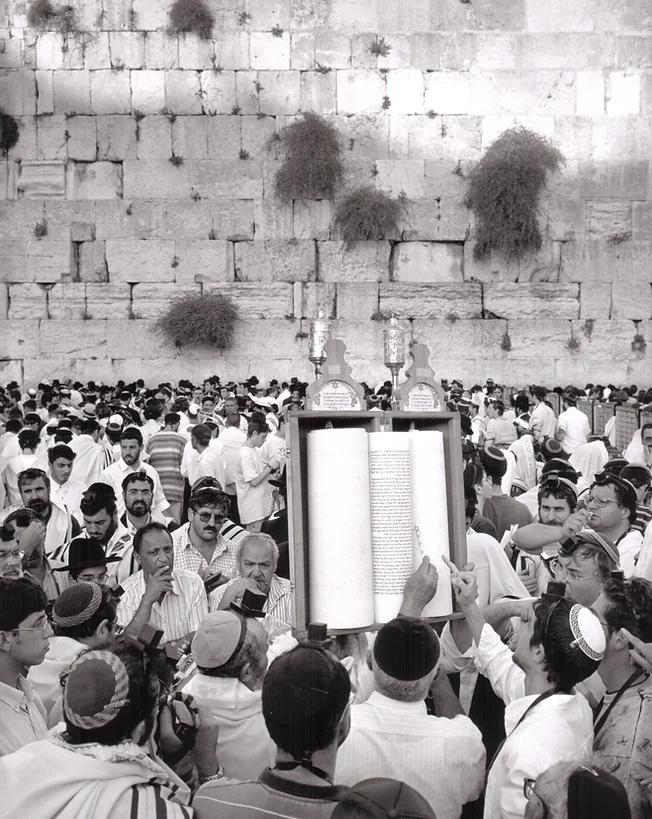The content and images in this curriculum and presentation are copyrighted and trademarked. Photographs’ subject matter is divided into categories. All photographs are by Zion Ozeri. You may only use the presentation or parts of it while implementing the DiverCity Lens in your school. For any other use, including reproduction, you must get special permission from Zion Ozeri. The use of the following content, which may be objectionable, is at your own risk, and Zion Ozeri holds no responsibility to evaluate the accuracy, completeness, and usefulness of any content provided, prior to your use. You may contact Zion Ozeri for any questions: zion@zionozeri.com
First Temple Destruction and the Babylonian Exile
Lesson Plan by Zion Ozeri and Josh Feinberg

9th of Av at the Wall, Jerusalem, Israel, 1997
All images © Zion Ozeri. All Rights Reserved.
Look closely at the photograph:
- Describe what you see in the photograph.
- Notice the shadow on the wall. What effect does the shadowy area have on the image?
- What elements draw your eye and focus your attention in the photograph? What divides the image and centers it?
- How does the photograph make you feel? Is there anything in this photograph that feels hopeful to you?
Tisha BAv, the ninth day of the Hebrew month of Av, marks the two most tragic days in ancient Jewish history. On the same date, hundreds of years apart, the Temple in Jerusalem was destroyed, Jews were slaughtered and exiled, and the sovereignty of the Jewish people in the land was brought to an end. It was carried out first by the Babylonian Empire in 587 BCE, and then (after the Temple was rebuilt by the returning exiles) again by the Roman Empire in 70 CE.Jews around the world observe Tisha BAv by fasting, praying, and recalling these tragic events in Jewish history. Tisha BAv always falls during the hot days of summer in Israel. The worshippers in this photo have gathered to mark the day at the Western Wall part of the retaining wall that supported the Second Temples foundation.
Learn more here:
The Temple and its Destruction | My Jewish Learning
The Jewish Temples: The Babylonian Exile
Now read this text:
This biblical verse from the book of Lamentations was written following the destruction of the First Jerusalem Temple and the exile of the Jewish population.
Lamentations 1:16
This is why I weep and my eyes overflow with tears. No one is near to comfort me, no one to restore my spirit. My children are destitute because the enemy has prevailed.
- Describe the feelings expressed by the writer. What specific imagery is used?
- Does this verse resonate with you today? Why or why not?
- What places or objects are most important to you? Describe how you would feel if they were taken away.
- How does this verse relate to the photograph above?
- Listen to Bob Marley's singing the song "By the Rivers of Babylon."
- The words of this song are adapted from Psalm 137 and reflect the desire of the exiled Babylonian Jews to return to the Land of Israel.
- To read the chapter in Psalms, click here: Psalm 137 in Hebrew and English - Sefaria
- What does it mean to be "in exile"?
- Do you know of any people who are in exile today?
- Have you ever felt like you were in exile? What was the situation? How did it feel?
Follow up activity:
- Choose an object from your home that is an important relic from your familys history (e.g., an heirloom that has been passed down, a specific piece of jewelry or artwork or piece of Judaica, etc.). Then, take a series of photographs of the object, both by itself and with different family members (including different generations). Try to capture its importance as a piece of family history in the past and in the present. Then, write "the objects story, from those who first possessed it through its journey to your home. You may write from the perspective of the object itself or from that of any person who ever owned it. Your writing should reflect on the objects significance in connecting the past with the present. Photographs and stories may be shared in a future class.
